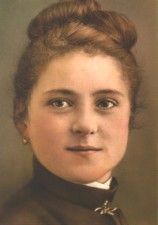Bloom Where You Are
The radical theology of Therese of Lisieux
 By Ma. Ceres Doyo
By Ma. Ceres Doyo
Through her pen the world learned about the story of her soul and her wondrous journey into deep intimacy with God. She did not have a huge following when she was alive for she lived in obscurity in a Carmelite monastery. She did not leave behind large missionary foundations. But through her writing that were made public after she died at the age of 24 in 1897, people got to know her and were amazed at the depth of her spirituality.
Saint Therese of the Child Jesus and the Holy Face, popularly known as Saint Therese of Lisieux or the Little Flower, has arrived in the country. Most Filipinos know her as Santa Teresita. Her relics arrived for a three-month journey across the Philippines and some parts of Asia. The veneration of relics of saints is not idolatry. According to a primer on St. Therese relics, “The veneration must be seen in the way men and women of all ages and cultures venerate the dead and pray in front of her mortal remains. The relics of the saints, meditations of their presence and memorials of their historical existence evoke their humanity – the way they lived, worked, suffered and prayed. Through their relics, God manifest His presence and shows forth His might and glory.” Bishop Ramon Arguelles, Military Vicar and Chair of the millennium Saint Foundation, says that in welcoming Therese’s relics, and her little way of confidence and love, the Church welcomes God’s merciful love. He quotes the Bible, saying: “And a little Child shall lead us.”
